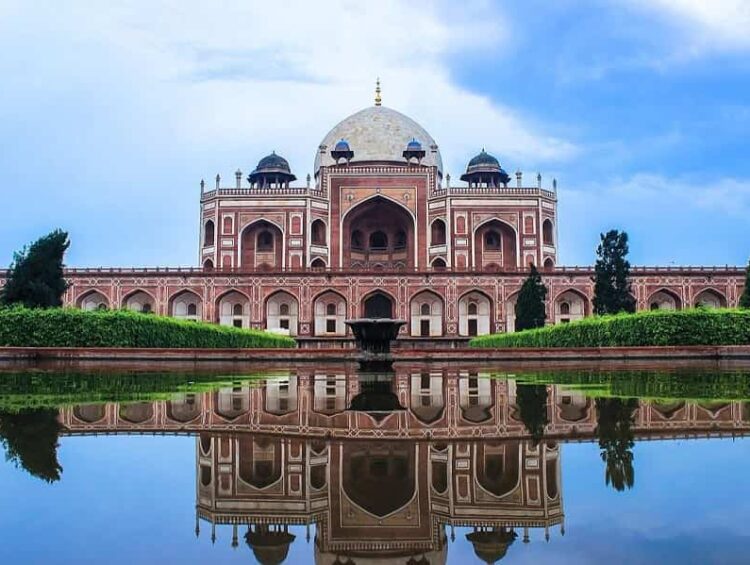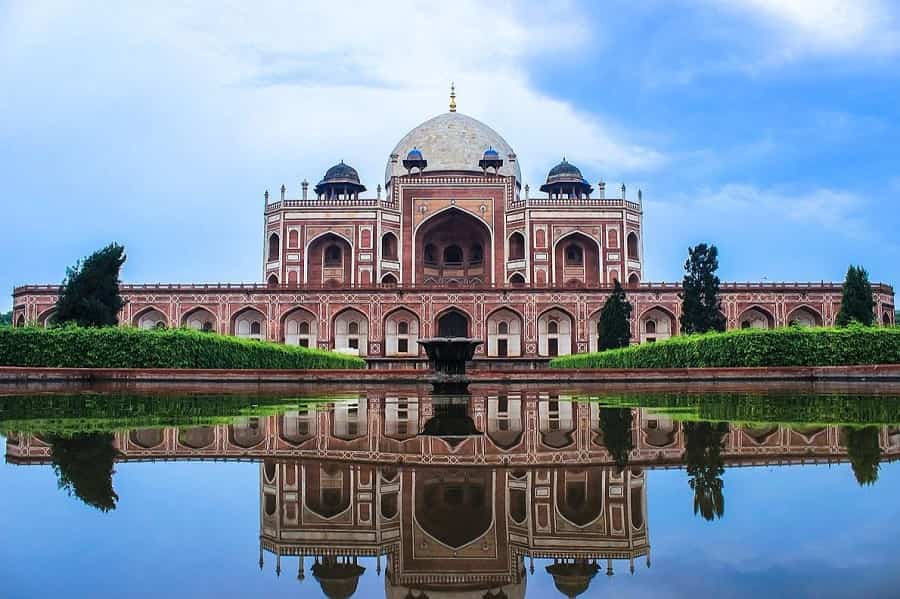- Location- Opp. Dargah Nizamuddin, Mathura Road
- Metro Station- JLN Stadium
- Open- Daily
- Timings- Sunrise to sunset
- Entry Fee- 10 (Indians), 250 (foreigners)
- Photography Charges- Nill (`25 for video filming)
Humayun was a popular Mughal emperor and Humayun’s tomb is built in memory of this King. The tomb was specially built by order of Bega Begum (Haji Begum), first wife of Humayun between years 1569-70. The tomb was designed by a Persian architect Mirak Mirza Ghiyas who was chosen among many by Bega Begum for this task. The tomb has distinction of being first garden-tomb in India. The tomb is located in Delhi at Nizamuddin East. The tomb is nearby to Dina-panah citadel which is popularly known as Purana Qila (or Old Fort), which was founded by Humayun in year 1533. The tomb which is considered as first historical monument to be constructed using red sandstone also features in list of World Heritage Site declared by UNESCO. The monument has undergone several renovation works since its inclusion in UNESCO list in 1993. Apart from main Humayun tomb there are several small monuments which adore main way leading to main gate in west direction. The monument also features a complex which is named after Isa Khan Niyazi, who was an Afghan ruler in court of Sher Shah Suri. He was known for his valor and fought the Mughals.
The site for construction of tomb was specially selected on river Yamuna bank due to its nearness to Nizamuddin Dargah, mausoleum of popular Sufi saint Nizamuddin Auliya of Delhi. He was held with great respect by rulers of Delhi. Residence of Chilla Nizamuddin Auliya was located on north-east direction of the tomb. It is also believed that last Mughal ruler, Bahadur Shah Zafar took shelter here during period of revolt of 1857, along with three other princes before being sent on exile to Rangoon by Captain Hodson. During the rule of Slave Dynasty this land came under territory of ‘Kilokheri Fort’ and capital of son of Nasiruddin.
Architecture of Tomb
The tomb can be accessed through the two gigantic double-storied gateways located at south and west side which is sixteen meter high. There are rooms built on both side of passage with a small courtyard on the upper floor. The tomb which is built using red sandstone makes use of white marble for outside designs and for flooring. The door frames, jaalis and chhajja are also made of marble. The complete base structure is developed on a raised platform. The complete exterior of dome is developed using white stones whereas the other areas are designed using red sandstone, with occasional black, yellow, and white marble sandstone to avoid dullness to viewers.
The architectural symmetry of exterior portion bears a sharp contrast with complicated interior floor designs in inner portion. The white dome is part of main structure and contains a domed chamber below which is present a central burial chamber in octagonal shape. This structure contains a cenotaph of Humayun. This place can be accessed through a narrow passage which is opened from south side and covered with complex stone lattice work. The actual burial chamber where emperor rests in peace lies exactly below the upper cenotaph. The burial chamber can be reached through a different passage which commences from outside the main structure and usually remains closed for public viewing. The marble designs and ornamentation displays best architectural culmination of Indo-Islamic culture. The same architectural ideas were used in many of other monuments built by Mughals including first wonder of the world Taj Mahal.
- Suggested Tour: Delhi Agra Jaipur Golden Triangle Tour
Best Time to Visit
The ideal time to visit capital city and Humayun’s Tomb is from Oct to March. The weather remains pleasant with onset of mild winter in October month. Greenery and flowers are the best sight in and around Humayun’s tomb during this season. Tourists can have a memorable vacation during this time of year.
How to Reach
By Flight
Delhi being national capital of India is well connected with both International and domestic flights. Indira Gandhi International Airport is one of the busiest airports in India. Flights from all airlines operate from this airport. The airport also has a domestic terminal which takes care of all domestic airlines operating between Delhi and all other major cities of India.
By Road
Delhi has numerous National Highways and Road networks passing through it. These networks connect the national capital with various cities of country. For better and comfortable travel for passengers there are three prominent bus stands in Delhi.
- Sarai Kale-Khan Bus Terminus
- ISBT or Inter State Bus Terminus- (Kashmiri Gate)
- Anand Vihar Bus Terminus.
Tourists can get both private and government bus facilities from these terminals. Facilities for government pre-paid taxis and private taxis also exist.
- Suggested Tour: Old Delhi Heritage Tour





